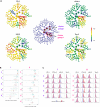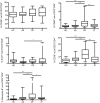Differential expression pattern of co-inhibitory molecules on CD4+ T cells in uncomplicated versus complicated malaria
- PMID: 29555909
- PMCID: PMC5859076
- DOI: 10.1038/s41598-018-22659-1
Differential expression pattern of co-inhibitory molecules on CD4+ T cells in uncomplicated versus complicated malaria
Erratum in
-
Author Correction: Differential expression pattern of co-inhibitory molecules on CD4+ T cells in uncomplicated versus complicated malaria.Sci Rep. 2018 Nov 29;8(1):17587. doi: 10.1038/s41598-018-36410-3. Sci Rep. 2018. PMID: 30487585 Free PMC article.
Abstract
The immune response of malaria patients is a main factor influencing the clinical severity of malaria. A tight regulation of the CD4+ T cell response or the induction of tolerance have been proposed to contribute to protection from severe or clinical disease. We therefore compared the CD4+ T cell phenotypes of Ghanaian children with complicated malaria, uncomplicated malaria, asymptomatic Plasmodium falciparum (Pf) infection or no infection. Using flow cytometric analysis and automated multivariate clustering, we characterized the expression of the co-inhibitory molecules CTLA-4, PD-1, Tim-3, and LAG-3 and other molecules implicated in regulatory function on CD4+ T cells. Children with complicated malaria had higher frequencies of CTLA-4+ or PD-1+ CD4+ T cells than children with uncomplicated malaria. Conversely, children with uncomplicated malaria showed a higher proportion of CD4+ T cells expressing CD39 and Granzyme B, compared to children with complicated malaria. In contrast, asymptomatically infected children expressed only low levels of co-inhibitory molecules. Thus, different CD4+ T cell phenotypes are associated with complicated versus uncomplicated malaria, suggesting a two-sided role of CD4+ T cells in malaria pathogenesis and protection. Deciphering the signals that shape the CD4+ T cell phenotype in malaria will be important for new treatment and immunization strategies.
Conflict of interest statement
The authors declare no competing interests.
Figures




References
-
- World Malaria Report. (World Health Organization, http://apps.who.int/iris/bitstream/10665/252038/1/9789241511711-eng.pdf?..., 2016).
MeSH terms
Substances
LinkOut - more resources
Full Text Sources
Other Literature Sources
Research Materials

